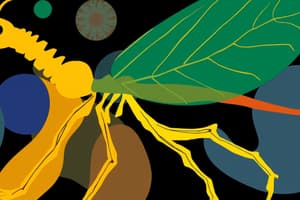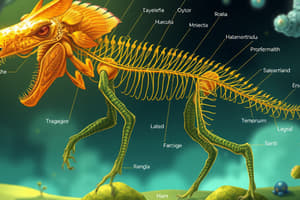Podcast
Questions and Answers
There have been many different ideas of how to _______________ living things.
There have been many different ideas of how to _______________ living things.
classify
Arostotle placed all living things into groups—plants and _______________.
Arostotle placed all living things into groups—plants and _______________.
animals
Carolus Linnaeus grouped all living things into two main _______________.
Carolus Linnaeus grouped all living things into two main _______________.
groups
In 1969 an American biologist proposed a five-kingdom system for classifying organisms that included kingdoms Monera, Protista, _______________, Fungi, and Animalia.
In 1969 an American biologist proposed a five-kingdom system for classifying organisms that included kingdoms Monera, Protista, _______________, Fungi, and Animalia.
The current system used for classifying _______________ is called systematics.
The current system used for classifying _______________ is called systematics.
Organisms are classified into one of three _______________—Bacteria, Archaea, and Eukarya—and then into one of six _______________.
Organisms are classified into one of three _______________—Bacteria, Archaea, and Eukarya—and then into one of six _______________.
When Linnaeus grouped organisms into kingdoms, he also developed a system for naming organisms. His system of _______________ gives each organism a two-word scientific name, such as Ursus arctos for a brown bear.
When Linnaeus grouped organisms into kingdoms, he also developed a system for naming organisms. His system of _______________ gives each organism a two-word scientific name, such as Ursus arctos for a brown bear.
A(n) _______________ is a group of organisms that have similar traits and produce fertile offspring.
A(n) _______________ is a group of organisms that have similar traits and produce fertile offspring.
In a scientific name, the first word is the organism's _______________, such as Ursus.
In a scientific name, the first word is the organism's _______________, such as Ursus.
The second word in a scientific name identifies the _____________________________________________.
The second word in a scientific name identifies the _____________________________________________.
Similar species are grouped into one _______________. Similar genera are grouped into _______________ and then into orders, classes, phyla, kingdoms, and domains.
Similar species are grouped into one _______________. Similar genera are grouped into _______________ and then into orders, classes, phyla, kingdoms, and domains.
Each species has its own ______________________________, which is the same all over the world.
Each species has its own ______________________________, which is the same all over the world.
A(n) _______________________ is a series of descriptions arranged in pairs that can be used to identify an unknown organism. The chosen description leads to another pair of descriptions or to the identification of the ______________________________.
A(n) _______________________ is a series of descriptions arranged in pairs that can be used to identify an unknown organism. The chosen description leads to another pair of descriptions or to the identification of the ______________________________.
A(n) _______________ is a branched diagram that shows the relationships among species. New characteristics appear before each _______________.
A(n) _______________ is a branched diagram that shows the relationships among species. New characteristics appear before each _______________.
Study Notes
Classifying Organisms
- Classification involves organizing living things based on shared characteristics.
- Aristotle's classification system divided all living organisms into two main categories: plants and animals.
- Carolus Linnaeus introduced a systematic approach, grouping organisms into two fundamental categories.
Five-Kingdom System
- In 1969, a five-kingdom system was proposed, which includes the kingdoms:
- Monera
- Protista
- Plantae
- Fungi
- Animalia
Current Classification System
- The modern classification system is termed 'systematics', which uses all available information about organisms for classification.
- Organisms fall under three primary domains: Bacteria, Archaea, and Eukarya, further categorized into six kingdoms.
Binomial Nomenclature
- Linnaeus developed binomial nomenclature, a two-word naming system for organisms.
- For example, the scientific name for a brown bear is Ursus arctos.
Understanding Species
- A species is defined as a group of organisms sharing similar traits capable of producing fertile offspring.
- In scientific nomenclature, the first word indicates the genus (e.g., Ursus), while the second describes specific characteristics.
Taxonomic Hierarchies
- Similar species are grouped into a genus, which is then classified into families, followed by orders, classes, phyla, kingdoms, and domains.
- Every species is assigned a unique scientific name, recognized universally.
Identification Tools
- A dichotomous key is a tool used for identifying unknown organisms, consisting of paired descriptions leading to either more descriptions or identification of the organism.
- A cladogram visually represents relationships among species, highlighting the emergence of new characteristics at each branch point.
Studying That Suits You
Use AI to generate personalized quizzes and flashcards to suit your learning preferences.
Description
This quiz explores the classification of organisms, including historical systems like Aristotle's and Linnaeus's contributions. It covers the five-kingdom system and the modern classification known as systematics. Test your understanding of binomial nomenclature and the definition of species.





